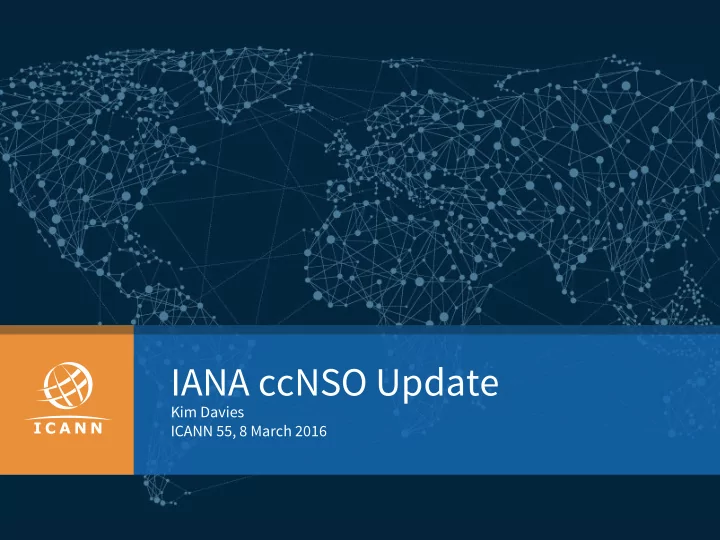

IANA ccNSO Update Kim Davies ICANN 55, 8 March 2016
Agenda ¤ Introduction to IANA ¤ Performance Overview ¤ Implementing new post-transition performance metrics ¤ Framework of Interpretation ¤ RDAP Update ¤ Other Work in Progress | 2
A reminder: What does IANA do? We’re record keepers for globally-unique Internet identifiers. For hierarchically assigned identifiers like domain names and IP addresses, we are the registry of registries. We tend to divide what we do into three primary areas, that represent the major community groups we partner with in doing those tasks: Protocol Parameters Domain Names Number Resources Port Numbers Media Types Manage Delegations and Y O U Root Zone A Zone Contents R E H IPv4 IPv6 AS E R E Maintain the Root Zone Service Codes Time Zones Key Signing Key Private Enterprise Numbers TLD 1 TLD 1 TLD 1 ... TLD n DNS Resource Record Types Regional Direct Protocol Command Flags Assignment Assignment Assignment Diagnostic Types Key Signing Ceremonies Service Types Character Sets .arpa registry .int registry Payload messages Property Types RIR 1 RIR 2 RIR 3 ... RIR n IDN tables HTTP Status Codes Label Generation Rulesets Internet Telephony Admin Domains Internet Engineering Task Force TLD Managers Regional Internet Registries | 3
TLD Growth 1400 1200 1000 800 600 400 200 0 ccTLD (ASCII) ccTLD (IDN) gTLD (ASCII) gTLD (IDN) Other | 4
Processing times and volumes 450 400 350 300 250 200 All requests 150 Rou0ne requests 100 50 0 20 15 10 5 0 | 5
SLE Development at IANA Implement changes to Convert raw data Finalise which Finalise reporting Decide what Evolve and adjust existing systems to into public data are the key measures to highlight should be measured reporting based capture needed streams (event logs, and what their performance and reported on feedback data points aggregate dashboards) thresholds are against thresholds 2 days 95% + 21 days 95% 4 hrs 99% Design Team A RZMS deployment Tools development A fu er a period of A fu er ICANN and Regular engagement CWG Final Report on 2 March commences next data collection when community agree with CSC and week trends emerge on thresholds periodic reviews | 6
SLE Development at IANA Implement changes to Convert raw data Decide what existing systems to into public data should be measured capture needed streams (event logs, and reported data points aggregate dashboards) + Design Team A RZMS deployment Tools development CWG Final Report on 2 March commences next week Provided subject matter expertise to Design Team to identify what is possible ¤ Implemented technical changes to systems to record new data ¤ Now developing system to crunch raw data to generate dra fu dashboards and other reporting ¤ | 7
SLE Development at IANA Finalise which Finalise reporting Evolve and adjust are the key measures to highlight reporting based and what their performance on feedback thresholds are against thresholds 2 days 95% 21 days 95% 4 hrs 99% A fu er a period of A fu er ICANN and Regular engagement data collection when community agree with CSC and trends emerge on thresholds periodic reviews | 8
Framework of Interpretation ¤ Approved by the ICANN Board at Buenos Aires meeting, sought dra fu implementation plan from sta ff ¤ ccNSO appointed liaisons (Becky Burr, Keith Davidson) to work with ICANN sta ff on developing implementation plan ¤ Meetings have been held with initial clarifying questions posed, more dra fu ing to be done before being ready for public comment and implementation. ¤ Open actions ¤ Response from ccNSO liaisons on open questions regarding manager consent ¤ Completion by ICANN of implementation plan dependent on ccNSO clarifications | 9
RDAP Support What is RDAP? IANA’s Role Registry Data Access Protocol One of the features RDAP has over WHOIS is automatic (RDAP) is a newly developed discovery of RDAP servers. You no longer have to technical standard from the manually find where the right server is for the data you IETF that provides next are looking up, the protocol will do this automatically. It generation access to does this by using “bootstrap registries” that are registration data. It is intended published as an IANA service. to be a successor to the WHOIS protocol, but can run in parallel with existing WHOIS servers. What’s new We have implemented bootstrap registries for IPv4, IPv6, AS numbers and Top-Level Domains. TLD Managers are now able to log into our Root Zone Management System to list their RDAP servers to appear in the bootstrap registry for the DNS. | 10
RDAP Support RDAP clients fetch bootstrap registry which lists known top-level RDAP servers Queries are fulfilled by connecting to RDAP servers listed in “services”: [ [ [ “fou”, “bar” ], [ “rdap.registrycorp” ] ], bootstrap registry [ [ “baz”, “rdap.baz.boop” ] ] ... ] TLD’s RDAP Server RDAP Bootstrap Registry | 11
Other Work in Progress Updates TCR Renewal Process Parallel Operations 1 4 Finalizing processes to select new Testing removing NTIA processing volunteers from the community to by running two services between oversee Root KSK operations, ICANN and Verisign, ensuring both including new travel support options. produce the same root zone. KSK Access Control Upgrades Label Generation Rulesets Improving logistics with the key 2 5 Finalising dra fu -ietf-lager- ceremony room to enhance security specification within the IETF with and provide for smoother plans to use LGRs in IANA’s ceremonies. workflow and IDN repository. Rollover of the Root KSK RZMS Development 3 6 Community design team has With transition related development produced a set of completing, re-evaluate work plan recommendations on how to on items discussed with ccNSO, replace the Root Zone key-signing including new authorizer model, key (KSK) for the first time. improved technical checks, bulk updates etc. | 12
Thank you! Full Width Photo or Video Here 350px x 650px | 13
Recommend
More recommend